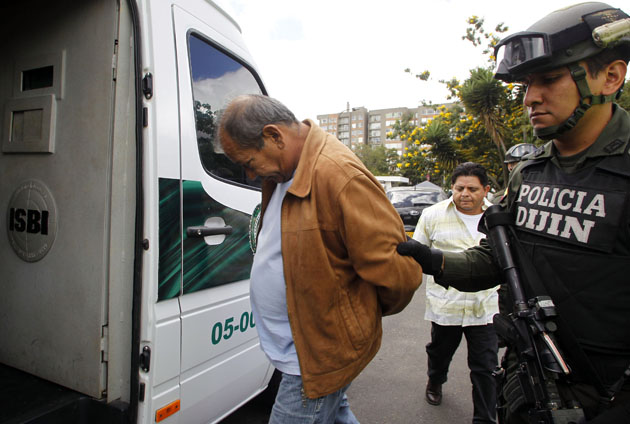Reuters photo
By
Ricardo Swire
In early April 2017 one of Spain’s most wanted felons, “El Canoso” or “Grey-Haired” was arrested in a restaurant in Armenia, Quindio, Colombia.
Previously, during February 2016, he managed to escape Spanish National Police Corps (CNP) officers when his drug trafficking extension in Spain was dismantled. Assisted by a qualified chemist El Canoso used a Colombian laboratory to infuse coal with cocaine. After smuggled consignments arrived in Spain local labs separated cocaine from the black sedimentary rocks.
Since 2010 El Canoso, former Commander of the “Tayrona Block,” managed transportation for Colombia’s notorious Urabenos and Ndrangheta drug cartels. He used a platform of airports in Bogota, Cali, Medellin, Sydney Australia, Amsterdam, Holland, Buenos Aires and Madrid Spain to achieve trafficking goals. According to a National Police of Colombia document “in one month he had revenues of over €5 million or US$5.3 million.” In 2012 the Colombian was listed as one of Latin America’s most wanted drug traffickers.
In 2014 El Canoso contributed to the Ndrangheta’s €53 billion or £44 billion drugs profit. The Colombian cartel’s multi-billion euros achievement placed its earning power ahead of corporate giants Deutsche Bank AG and American franchise McDonald’s restaurant. El Canoso’s Spanish syndicate was controlled by another Colombian called “Tatis.” The criminal group acted as wholesale supplier for micro trafficking sections in Zaragoza, Aragon, Spain. Cocaine retailed for US$79.50 per gram. The white powdered drug’s value usually depends on a “price curve.” Further away the cocaine moves from the producing country higher its market price.
One international monitoring agency, Havocscope Global Black Market (HGBM), calculated Spain’s drug trafficking value at US$95 billion. HGBM supplies credible data and threat intelligence pertaining to the criminal underworld. Information is collected from government agencies, academic studies and other trustworthy sources. Independent analysis of trafficking trends highlighted Spain as one main entry point for European Union (EU) drug shipments. Galicia, located in the northwest of the Iberian Peninsula, a preferred port of entry.
Three special smuggling corridors are maximized. The “Northern Route” charts courses from Caribbean Sea locations across to Spain and Portugal. Cocaine leaves outpost Caribbean islands aboard aircraft, via human drug mules and in luggage or cargo on commercial flights. Alternatively drug consignments are shipped to Venezuela, aboard cargo freighters and container ships, then onward to the Iberian Peninsula. The “Central Route” leaves Brazil and travels directly to the Iberian Peninsula.
According to the European Police Office (EUROPOL) traffickers coalesce drug transfer movements between cargo ships and go-fast boats transiting the African coast. The Azores, Cape Verde, Canary Islands and Madeira use fishing boats and speed boats to elude maritime law enforcement patrols. The “West African Route” starts in Gulf of Guinea countries, or off Cape Verde onwards to Europe, Argentinian, Bolivian, Brazilian, Colombian, Peruvian and Venezuelan drug traffickers exhausting this channel. The criminal groups in West Africa utilize small planes, illegal couriers and air freight to smuggle cocaine.
In one scenario Spanish Civil Guard officers intercepted a container of industrial cleaning equipment, inbound at Madrid-Barajas Airport from El Dorado International Airport in Bogota, Colombia. Spanish Gendarmeries welcomed the flight with X-Ray Machines and the anti-narcotics K-9 Unit. The consignment was not intercepted but followed to its final destination in the mountainous, coastal Cantabria district. Forty-six kilos of cocaine in multiple packets were hidden inside the cleaning equipment. One Spaniard and a Colombian trafficker arrested.
Not long ago narco-traffickers introduced the “Blind Hook.” A technique that requires small portions of cocaine to be hidden inside shipping containers without the bona fide sender’s knowledge. Chosen containers often belong to reputable companies and are dispatched to different areas of Spain. Such consignments arrive at Algeciras near Morocco in Barcelona. Valencia and Marin north of Portugal. Spain’s Special Response Group Organized Crime’s (GRECO) reported a minimum three thousand kilos of cocaine confiscated annually.
GRECO functions in tandem with Latin American counter-narcotics counterparts, American Drug Enforcement Administration (DEA) special agents and United Kingdom (UK) Serious Organized Crime Agency (SOCA) personnel, to counteract the Blind Hook. In October 2016 such international law enforcement cooperation was demonstrated. US DEA operatives discovered a £4.5million cocaine shipment dispatched from Santos Port, Brazil. In 2016 cocaine seizures at this port were six time higher than 2015. The drugs were concealed in a legitimate container of Brazilian sugar, transported aboard a Geneva based Mediterranean Shipping Company (MSC) vessel.
At its first port of call in Valencia, Spain the cocaine consignment and four other containers were transferred to another ship. GRECO officers, briefed by DEA colleagues, continued to monitor the drug shipment. While in Valencia a local criminal syndicate attempted to remove the security seals from the container but was unsuccessful. The voyage’s second leg took the shipment to Oman on the Arabian Peninsula’s southeastern coast. A strategically important transit station at the mouth of the Persian Gulf.
After entering Port Sultan Qaboos the cocaine was moved to another ship destined for Kenya. Intelligence sharing between GRECO and Kenyan law enforcement counterparts resulted in the Brazil originated multi–million euros drug shipment’s seizure. In 2013 America’s DEA established and vetted the elite sixteen member Kenyan Narcotics Unit (KNU). DEA administered lie detector, drugs tests and special training financed by the US military’s Africa Command. KNU officers are tasked with pursuing “high-profile” targets.



No Comments Yet!
You can be first to comment this post!